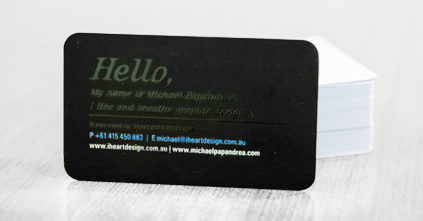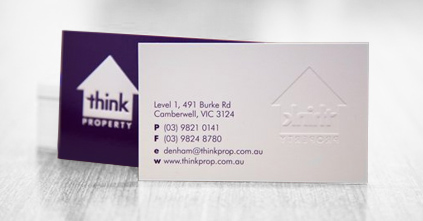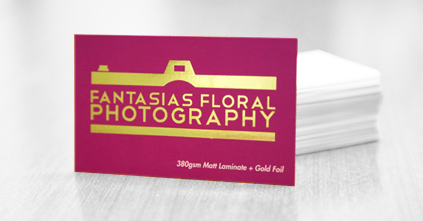How to make your business cards stand out.
While the business world has evolved rapidly in recent times, one thing’s for sure: a well-designed business card is still essential to create a great impression, connect with clients, and acquire new business.
While there are general principles involved in designing an impactful business card, there aren’t any strict rules or conventions.
The best advice? Create something that uniquely captures who you are, what you do, and why your potential clients should take notice.
If you’re hoping to create something that reflects your expertise and capability, you need to know your design options. Used creatively—with the right application—these techniques can help your business card stand out against the competition.
1. Create a uniquely shaped business card.

You’ve got a couple of options here, like round edged business cards (as shown above) or a die cut design, where you can cut your business card into completely custom shapes.
Top tip for creating a unique shape: Try to emphasise a visual or conceptual element on the face of your card by matching the shape you choose. For example, if you work as a specialised mechanic, you could alter the shape of your business card to mirror the silhouette of the type of vehicle you offer expertise in.
2. Use embossing to create an impression.

Embossed business cards feature an element of the design that is raised on one side (and invariably, indented on the other) to create a 3D effect that quite literally stands out against the competition.
Top tip for creating an embossed business card design:
Go for a simple approach, with:
- A strong, bold typeface (and not too many conflicting type styles)
- Simple, spacious visual elements (like the house logo in the example above)
- One or two colours only, using inverse colours to reiterate the differentiation of the embossed elements
- Only one or two elements of the card using the embossed effect
Embossing a simple logo is a great option because it creates a memorable association in the minds of clients. You wouldn’t, for example, emboss multiple intricate elements of your business card in close proximity to one another (like a name or telephone number), because the embossing effect will become harder to ‘read’ and therefore less impactful.
3. Give yourself the edge with a painted-edge design.
A painted-edge design features a splash of colour along the sides of your business card, usually in a thicker paper stock so there’s more space available for the ink to take hold, and therefore a more compelling visual impression. Painted edge designs work best with vibrant colours like pink, orange, electric blue, bright green, and yellow, rather than muted tones like charcoal, grey or brown.
Top tip for designing with a painted edge: Use a minimalist approach to the front and back faces of your business card design. That way, the edge painting becomes the primary focal point of the card, rather than competing or conflicting with multiple elements in the design.
4. Bring some flash with foils.

Foiled business cards feature a shiny, metallic texture which you can add to any element of your design: logos, text, or to highlight different parts of the imagery. Used sparingly, foiled finishes are perfect for creating an understated sense of high-end luxury and premium visual aesthetics—so they’re a great option for people in creative industries like design, photography, art direction, or branding specialists.
Top tip for designing a foiled business card: Foils typically work best on the premise that ‘less is more’. Ideally, the gold foil should take centre stage as the primary design element. You don’t want too many ideas fighting for attention, so try to stick with a limited number of colours, typefaces, and multiple visual elements.
5. Shine bright with spot UV.

A spot UV design—which is also sometimes referred to as a ‘spot gloss’—consists of a coating on the front face of your business card which creates a sleek, metallic sheen. The effect of the gloss coating is a subtle, shiny appearance which stands out against the non-glossed elements of your design.
Top tip for creating a stand-out business card with Spot UV: Spot UV works best with single colours, or slight variations of the one colour. For example, black and a very dark shade of grey, or in the above example, variants of pink on pink. Try to stick within a singular colour palette.
6. Bring the polish with a glossy finish.

Glossy business cards (sometimes also called ‘silk stock’) have a smooth, shiny surface across both faces of the card. Not only does it look great, but gloss finishing also provides a layer of protection to the card’s stock, so your design stays fresher, for longer.
Top tip for creating a design with a gloss finish:The glossy finish is perfect for designs that feature photography or brightly coloured designs, because the ink doesn’t absorb into the fibres of the stock. As a result, all your images will stay crisp, clean and vibrant.
Looking to create a business card that stands out and strengthens your network? Our fully customisable range of business cards is high-quality, affordable, and rapidly delivered anywhere in Australia. Plus, our team of designers is available to help you bring your artwork to life!
Check out our full range of business card options or call 1300 663 120.


